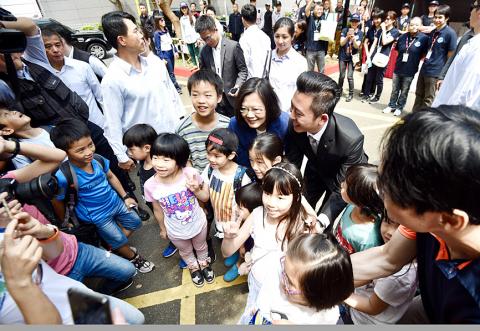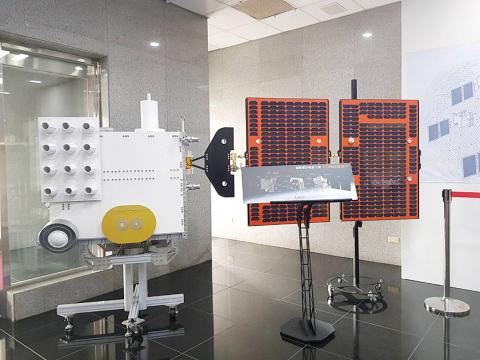The Formosat-7/COSMIC-2 satellite constellation was yesterday sent to Taoyuan International Airport to be forwarded via diplomatic pouch to the US today, while President Tsai Ing-wen (蔡英文) said it would be launched on June 22.
Tsai made the announcement at a ceremony held by the Ministry of Science and Technology at the National Space Organization (NSPO) at the Hsinchu Science Park (新竹科學園區).
The constellation is the biggest-ever collaborative program between Taiwan and the US, Tsai said.

Photo: Peter Lo, Taipei Times
Its launch on a SpaceX Falcon Heavy rocket would be more good news following the revelation on Wednesday of the first image of a black hole by an international group of scientists, including Academia Sinica researchers, she said.
Taiwan plays a vital role in international space programs and has an important role in the Indo-Pacific region, she said, expressing hope that the nation would be safe and its people are proud of being Taiwanese.
The constellation comprises six satellites and is designed to take over the mission of collecting weather data from the Formosat-3/COSMIC constellation, Minister of Science and Technology Chen Liang-gee (陳良基) said.

Photo: Chien Hui-ju, Taipei Times
Formosat-7 is expected to collect three or four times more data than its predecessor, which would improve weather forecasts and disaster prevention efforts, he said.
Each satellite is equipped with three important scientific payloads, the Tri-GNSS Radio Occultation System, an ion velocity meter and a radio frequency beacon, which would be managed by the US Air Force, the NSPO said.
Taiwan and the US each spent about NT$3.2 billion (US$103.6 million at the current exchange rate) on the program, sharing the total cost, NSPO Director-General Lin Chun-liang (林俊良) said.
The constellation would be sent to the US via diplomatic pouch, meaning that it would receive more courteous treatment and skip some inspection steps, Lin said.
After arriving at Miami International Airport, it is scheduled to reach the Kennedy Space Center at 6am tomorrow, he said.
Three hours after launch, the NSPO would know whether the constellation operates normally by examining the data it transmits through a signal reception station in Darwin, Australia, Lin said.
The launch has been postponed several times.
The constellation was to originally comprise of two groups of six satellites, but the development of the second group was canceled in October 2017 due to budget concerns in the US.
Changing policies and technical negotiations were the most challenging parts of the development process, said Formosat-7 project head Chu Chung-hui (朱崇惠), the NSPO’s first female project head, but added that space programs usually take a long time to come to fruition.

TRAGEDY STRIKES TAIPEI: The suspect died after falling off a building after he threw smoke grenades into Taipei Main Station and went on a killing spree in Zhongshan A 27-year-old suspect allegedly threw smoke grenades in Taipei Main Station and then proceeded to Zhongshan MRT Station in a random killing spree that resulted in the death of the suspect and two other civilians, and seven injured, including one in critical condition, as of press time last night. The suspect, identified as a man surnamed Chang Wen (張文), allegedly began the attack at Taipei Main Station, the Taipei Fire Department said, adding that it received a report at 5:24pm that smoke grenades had been thrown in the station. One man in his 50s was rushed to hospital after a cardiac arrest

A car bomb killed a senior Russian general in southern Moscow yesterday morning, the latest high-profile army figure to be blown up in a blast that came just hours after Russian and Ukrainian delegates held separate talks in Miami on a plan to end the war. Kyiv has not commented on the incident, but Russian investigators said they were probing whether the blast was “linked” to “Ukrainian special forces.” The attack was similar to other assassinations of generals and pro-war figures that have either been claimed, or are widely believed to have been orchestrated, by Ukraine. Russian Lieutenant General Fanil Sarvarov, 56, head

SAFETY FIRST: Double the number of police were deployed at the Taipei Marathon, while other cities released plans to bolster public event safety Authorities across Taiwan have stepped up security measures ahead of Christmas and New Year events, following a knife and smoke bomb attack in Taipei on Friday that left four people dead and 11 injured. In a bid to prevent potential copycat incidents, police deployments have been expanded for large gatherings, transport hubs, and other crowded public spaces, according to official statements from police and city authorities. Taipei Mayor Chiang Wan-an (蔣萬安) said the city has “comprehensively raised security readiness” in crowded areas, increased police deployments with armed officers, and intensified patrols during weekends and nighttime hours. For large-scale events, security checkpoints and explosives

PUBLIC SAFETY: The premier said that security would be tightened in transport hubs, while President Lai commended the public for their bravery The government is to deploy more police, including rapid response units, in crowded public areas to ensure a swift response to any threats, President William Lai (賴清德) said yesterday after a knife attack killed three people and injured 11 in Taipei the previous day. Lai made the remarks following a briefing by the National Police Agency on the progress of the investigation, saying that the attack underscored the importance of cooperation in public security between the central and local governments. The attack unfolded in the early evening on Friday around Taipei Main Station’s M7 exit and later near the Taipei MRT’s Zhongshan